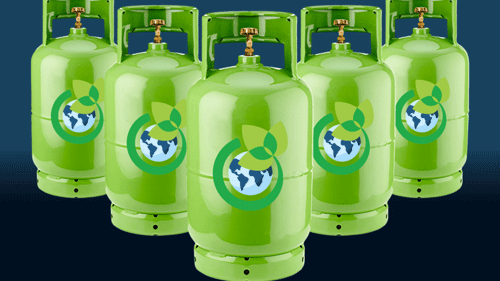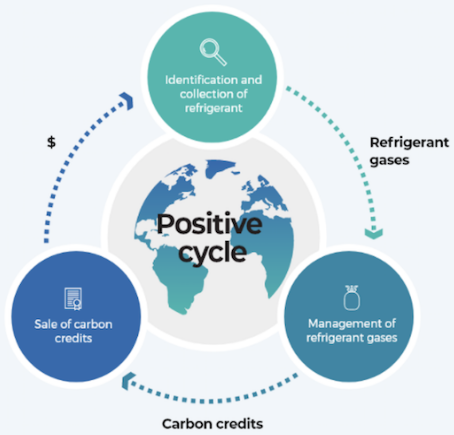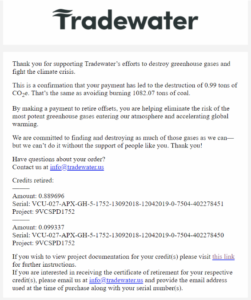December 13, 2021
How Purchasing Tradewater Carbon Credits On Requis Works
In this article:
- FAQ about purchasing carbon credits on Requis.
- How you can prove you’ve purchased bona fide carbon offsets.
- How Tradewater carries out its projects.
Dramatically improving the sustainability and circularity of our supply chains is essential to the health of our planet and our own survival. With that goal in mind, Requis now offers Tradewater carbon offset credits on its platform. Users can purchase these carbon credits to help offset the carbon footprint of their organization’s activities. This article provides details about how this works.
You can read our original article about carbon credits from Tradewater on the platform, which includes more information on why refrigerants are such massive contributors to climate change.

Buy Carbon Credits On Requis FAQs
1. Why is Requis Offering Carbon Credits on the Platform?
We’ve always felt that sustainability is an important part of our mission to simplify supply chain and asset management. We’re big believers in the circular economy. When companies buy and sell surplus and used parts and equipment from each other, it means fewer resources need to be mined and processed to make new ones. This helps reduce damage to our environment in many ways.
We feel that integrating the ability to purchase carbon offset credits into the platform is a natural fit. You can learn more about why we’re doing this here.
2. Why Should I Buy Carbon Offset Credits from Tradewater?
Put simply, Tradewater sells credits that are among the highest quality on the market. These credits are generated directly from Tradewater’s completed greenhouse gas emission prevention projects, which meet the latest commonly accepted standards for carbon offset quality as defined by The World Wildlife Foundation, Environmental Defense Fund, and other prominent organizations.
Tradewater works in the USA and around the world, finding, purchasing, collecting and destroying older refrigerants like CFCs and HCFCs. These ozone depleting substances are also highly potent greenhouse gases—up to 10,900 times more powerful than carbon dioxide. If left alone and released into the atmosphere, these gases contribute to global warming and ozone layer depletion.
3. How Do Tradewater’s Projects Work?

Image courtesy Tradewater.
While some carbon offset programs accept your money and then, for example, go out and plant trees, Tradewater finances the work and carries it out first. This offers buyers confidence that the environmental impact they are supporting has had immediate, permanent impact.
The complexities of global refrigerant regulation and use mean that Tradewater doesn’t always know where or when refrigerants will be found. As a result, Tradewater builds relationships around the world, keeping the lines of communication open all the time, and must be ready to collect refrigerant immediately.
Ongoing funding through the purchase of carbon credits is essential in order to keep this positive cycle of reinvestment going. No one else is going to destroy these greenhouse gases unless a company like Tradewater does it.
Every Tradewater project is reviewed by third-party verifiers through a rigorous auditing process to confirm that the appropriate offset protocol rules were followed, and then the right number of carbon credits are generated and become available for purchase. Proceeds from the sale of the carbon credits are then invested in new projects to find and destroy more gases.
Tradewater’s goal is to scale up to the point where they can destroy enough refrigerant gases to generate and sell over three million carbon credits per year. There are still vast numbers of refrigerant containers on private properties, in old stockpiles, and in existing HVAC systems for commercial buildings around the world. None of these containers were designed for long-term storage, and if the containers fail, the greenhouse gases will leak into our atmosphere. It’s one of the biggest ticking time bombs in the environment today.
4. What Do I Get That Proves My Contribution?

Image courtesy Tradewater.
When you purchase carbon credits on the Requis platform, Tradewater draws up a contract with your organization. You will then receive an email certificate from either the American Carbon Registry (ACR) or the Verra Registry. The certificate provides the unique ID numbers for the project and the credits you’ve purchased. It also says that the credits have either been retired in your organization’s name or have been added to your account (more on “retiring” credits vs transferring credits below).
Tradewater will also email you their own certificate that confirms the same thing.
No one else can use the carbon offset credits that you have purchased. If you wish, you can look up the project and carbon credit numbers on the relevant registry online and confirm that the numbers are real and have been assigned to your organization.
Once you have retired the credits, you can then mention them in your ESG reports and marketing communications, knowing that you can prove that you’ve really purchased the credits.
5. What Does a “Retired” Carbon Credit Mean? Why Would I Retire a Credit Versus Transfer It?
Requis sells two different types of Tradewater credits on the platform: ones you can retire and ones you can transfer.
Retiring a credit means that you are allocating the credit to your organization, as opposed to holding on to it so that you can give or sell the credit to another party. When you retire a credit, you can be sure that the environmental benefit it represents is in your company’s name, and no one else can claim it.
For example, if your company generated 10,000 metric tons of carbon dioxide emissions this year, you could buy carbon credits to balance those emissions and retire the credits to achieve carbon neutrality.
But say that you know you’ll be creating even more emissions next year, and on top of that, you know your customers also like to receive carbon offset credits with their purchases so that they become carbon neutral. In a situation like this, you could buy 25,000 carbon offset credits, hold on to them, and retire them as you reach emissions milestones and/or transfer them when you make sales to customers.
If you want to be able to hold and transfer credits, your organization needs to have an account with a registry (either the Verra Registry or California’s ACR). When you purchase the credits, you get an email confirming that the credits have been moved to your account, similar to the email mentioned in #3, above. You can then retire the credits as needed and/or transfer them to the accounts of other stakeholders, like your customers.
The unique serial numbers for each credit and the accompanying project ID allows for tracking of the entire history of each credit from its creation by Tradewater, through each successive holder, and ultimately to the organization that retires it. Once it’s retired, a credit can’t be traded anymore.
As mentioned, this is very useful for companies who want to sell products that are carbon neutral. If you’re a manufacturer selling a part on Requis that resulted in the release of five metric tons of carbon dioxide emissions, you can bundle the carbon credits with the product to balance those emissions.
6. What Are Carbon Credit Registries and Why Do They Matter?
Tradewater carbon credits are available through two different registries: the American Carbon Registry (ACR) and the Verra Registry. Each is unique and issues its own serial numbers. Each registry also has strict criteria for projects, to ensure that they actually prevent greenhouse gas emissions or remove them from the atmosphere.
Companies who are participating in the California cap and trade system will have an account with the Compliance Instrument Tracking System Service (CITSS) through which they purchase offset credits.
Verra is an independent third-party organization that develops and maintains a variety of standards and frameworks for climate change and sustainable development programs. This includes the Verified Carbon Standard and the Verra Registry.
The Verra Registry lists certified greenhouse gas removal and prevention projects, related documentation, and the unique carbon offset credit numbers.
7. How Do I Know that Tradewater Carbon Credits Help Fight Climate Change?
All Tradewater projects and carbon credits are audited and verified by third party verification bodies, then approved by either Verra or the American Carbon Registry. You can learn about the ACR’s verification processes and standards on their website, and the same is true for Verra.
All certified carbon offset projects must prevent greenhouse gases (GHGs) or remove greenhouse gases from the atmosphere in a way that is permanent and unique. In other words, without the project, the greenhouse gases would be in the atmosphere, contributing to climate change.
Verra’s programs are trusted by a wide variety of stakeholders, and are the world’s most widely used voluntary GHG program, with nearly 1,700 certified projects. It’s also the Environmental Finance Voluntary Carbon Market Rankings Winner for 2021 for the “Best GHG Crediting Program” and “Best Registry Provider” categories. Verra is also an Offset Project Registry for the Air Resources Board Compliance Offset Program, under the California cap-and-trade system.
You can look up Tradewater projects on the Verra and ACR platforms:
Let’s Do Our Part to Help Fight Climate Change
There’s a lot of work for industry to do to help change how the global aggregate supply chain works. While our most innovative minds are working on solutions, carbon offset credits can help balance the scales towards carbon neutrality.
If you have questions that haven’t been answered here, please reach out to support@requis.com or contact us.
View Tradewater Carbon Credits on the Requis Platform >
Note For Private Individuals
Requis sells Tradewater credits on its platform so that companies can offset their activities at an appropriate but flexible scale. If you’re someone who is looking to offset personal emissions, however, you can do so using Tradewater’s carbon footprint calculator. This tool allows you to purchase carbon offset credits on a much smaller scale suitable for individuals.
